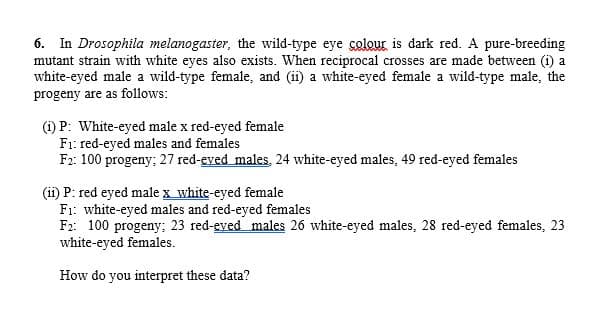6. In Drosophila melanogaster, the wild-type eye colour is dark red. A pure-breeding mutant strain with white eyes also exists. When reciprocal crosses are made between (i) a white-eyed male a wild-type female, and (ii) a white-eyed female a wild-type male, the progeny are as follows: (1) P: White-eyed male x red-eyed female F1: red-eyed males and females F2: 100 progeny; 27 red-eved males, 24 white-eyed males, 49 red-eyed females (ii) P: red eyed male x white-eyed female F1: white-eyed males and red-eyed females F2: 100 progeny; 23 red-eved males 26 white-eyed males, 28 red-eyed females, 23 white-eyed females. How do you interpret these data?
6. In Drosophila melanogaster, the wild-type eye colour is dark red. A pure-breeding mutant strain with white eyes also exists. When reciprocal crosses are made between (i) a white-eyed male a wild-type female, and (ii) a white-eyed female a wild-type male, the progeny are as follows: (1) P: White-eyed male x red-eyed female F1: red-eyed males and females F2: 100 progeny; 27 red-eved males, 24 white-eyed males, 49 red-eyed females (ii) P: red eyed male x white-eyed female F1: white-eyed males and red-eyed females F2: 100 progeny; 23 red-eved males 26 white-eyed males, 28 red-eyed females, 23 white-eyed females. How do you interpret these data?
Biology: The Unity and Diversity of Life (MindTap Course List)
14th Edition
ISBN:9781305073951
Author:Cecie Starr, Ralph Taggart, Christine Evers, Lisa Starr
Publisher:Cecie Starr, Ralph Taggart, Christine Evers, Lisa Starr
Chapter14: Chromosomes And Human Inheritance
Section: Chapter Questions
Problem 3GP: Human females have two X chromosomes (XX); males have one X and one Y chromosome (XY). a. With...
Related questions
Question

Transcribed Image Text:6. In Drosophila melanogaster, the wild-type eye colour is dark red. A pure-breeding
mutant strain with white eyes also exists. When reciprocal crosses are made between (i) a
white-eyed male a wild-type female, and (ii) a white-eyed female a wild-type male, the
progeny are as follows:
(1) P: White-eyed male x red-eyed female
F1: red-eyed males and females
F2: 100 progeny; 27 red-eved males, 24 white-eyed males, 49 red-eyed females
(ii) P: red eyed male x white-eyed female
F1: white-eyed males and red-eyed females
F2: 100 progeny; 23 red-eved males 26 white-eyed males, 28 red-eyed females, 23
white-eyed females.
How do you interpret these data?
Expert Solution
This question has been solved!
Explore an expertly crafted, step-by-step solution for a thorough understanding of key concepts.
This is a popular solution!
Trending now
This is a popular solution!
Step by step
Solved in 3 steps with 2 images

Knowledge Booster
Learn more about
Need a deep-dive on the concept behind this application? Look no further. Learn more about this topic, biology and related others by exploring similar questions and additional content below.Recommended textbooks for you

Biology: The Unity and Diversity of Life (MindTap…
Biology
ISBN:
9781305073951
Author:
Cecie Starr, Ralph Taggart, Christine Evers, Lisa Starr
Publisher:
Cengage Learning

Biology: The Dynamic Science (MindTap Course List)
Biology
ISBN:
9781305389892
Author:
Peter J. Russell, Paul E. Hertz, Beverly McMillan
Publisher:
Cengage Learning

Biology 2e
Biology
ISBN:
9781947172517
Author:
Matthew Douglas, Jung Choi, Mary Ann Clark
Publisher:
OpenStax

Biology: The Unity and Diversity of Life (MindTap…
Biology
ISBN:
9781305073951
Author:
Cecie Starr, Ralph Taggart, Christine Evers, Lisa Starr
Publisher:
Cengage Learning

Biology: The Dynamic Science (MindTap Course List)
Biology
ISBN:
9781305389892
Author:
Peter J. Russell, Paul E. Hertz, Beverly McMillan
Publisher:
Cengage Learning

Biology 2e
Biology
ISBN:
9781947172517
Author:
Matthew Douglas, Jung Choi, Mary Ann Clark
Publisher:
OpenStax